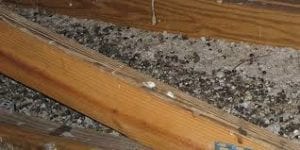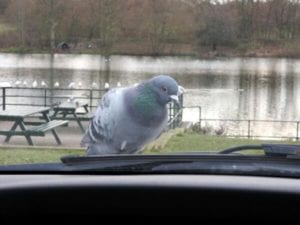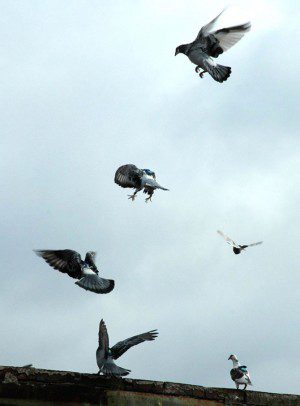
by Pigeon Patrol | May 23, 2023 | Bird Spike, Pigeon Droppings, Pigeon Patrol's Services, Pigeon Predators, Pigeon Spikes, Pigeons, Pigeons in the News
Pigeons are always on the lookout for a source of food and buildings with plenty of high nooks and crannies to roost and nest in, and your factory might just fit the bill.
But if pigeons get into your factory, it’s a serious problem. These pest birds and their guano (poo) carry and spread some nasty diseases, and they can also damage property. This is bad news for any business, but if food is manufactured, packaged, and stored in your factory, it can be disastrous.
Before your reputation and your profits take a serious hit, read our advice on how you can keep pigeons out of your factory.
How to prevent pigeons from getting into your factory
First, eliminate any sources of food
Any sources of food will be very attractive to pigeons, and eliminating them will make your factory less desirable to roost or nest in. Keep your factory scrupulously clean and don’t leave food ingredients or waste lying around, inside or outside of the premises.
It’s also a good idea to talk to nearby businesses if their poor waste management or housekeeping practices are attracting pest birds to the vicinity.
Second, use deterrents
When you are trying to prevent pigeons from nesting or roosting in or on your property, deterrents like bird spikes, bird wire, and netting can be effective at keeping them at bay.
Third, fix up your factory
If there are holes in your factory roof or walls that you haven’t got around to fixing, you could inadvertently be providing pigeons with the perfect nesting place. Make sure you fix them up-deterring pigeons is all about making your factory much less attractive to them.
Finally, deal with the guano
As we mentioned earlier, pigeon droppings can contain some harmful bacteria, so we would recommend that you don’t try to clean it up yourself.
If pest pigeons have made a mess of your factory, call in the professionals. We will blast away guano with the right equipment and products so your premises is clean, safe, and hygienic again.
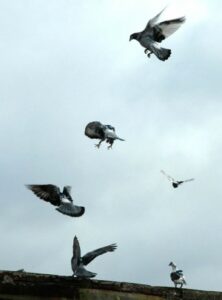
Do I need professional pigeon control for my factory?
As birds are protected by the Wildlife and Countryside Act 1981, it’s illegal to poison or shoot them if you don’t have a license. If you put poison down, you could harm other birds and end up in legal trouble. And not only that, if you’re a food business, you won’t be able to use toxic bird control methods anyway as you could contaminate your product.
If you hire professional pest control, you can get your pest problem dealt with fast. We can deal with any existing infestation, install effective bird-proofing and deterrents, and give you expert advice on preventing any problems in the future.
Source
Pigeon Patrol Products & Services is the leading manufacturer and distributor or bird deterrent (control) products in Canada. Pigeon Patrol products have solved pest bird problems in industrial, commercial, and residential settings since 2000, by using safe and humane bird
deterrents with only bird and animal friendly solutions. At Pigeon Patrol, we manufacture and offer a variety of bird deterrents, ranging from Ultra-flex Bird Spikes with UV protection, Bird Netting, 4-S Bird Gel and the best Ultrasonic and audible sound devices on the market today.
Voted Best Canadian wholesaler for Bird Deterrent products ten years in a row.
Contact us at 1 877-4-NO-BIRD,(604) 585-9279 or visit our website at www.pigeonpatrol.ca
Pigeon/Pigeon Patrol / Pigeons Roosing / Vancouver Pigeon Control / Bird Spikes / Bird Control / Bird Deterrent / PIgeon Deterrent / Surrey Pigeon Control / Pest / Seagull deterrent / Vancouver Pigeon Blog / Birds Inside Home / Pigeons in the cities / Ice Pigeons / What to do about pigeons / sparrows, Damage by Sparrows, How to Keep Raccoons Away, Why Are Raccoons Considered Pests / De-fence / Pigeon Nesting / Bird Droppings / Pigeon Dropping / woodpecker control / Professional Bird Control Company / Keep The Birds Away / Birds/rats/seagull/pigeon/woodpecker/dove/sparrow/pidgeon control/pidgeon problem/pidgeon control/flying rats/pigeon problems/ bird netting/bird gel/bird spray/bird nails/bird guard

by Pigeon Patrol | May 18, 2023 | Bird Spike, Pigeon Predators, Pigeon Spikes, Pigeons, Pigeons in the News, Raccoons, Sparrows, UltraSonic Bird Control
NICK OUD knows when to put his faith in a bird. As he clasps a homing pigeon between his hands, he looks for three things: curiosity, toughness, and stubbornness. A bird with these qualities is likely to go the distance. His benchmark is a remarkable hen named Lady Hearst, who won a mammoth 800-kilometre race in 2015.

Bird droppings on building window
The odyssey started in Hearst, Ontario, a town of about 5,000 people off the Trans-Canada Highway between Thunder Bay and Timmins. It began, as all pigeon races do, with a trailer resembling a wall of PO boxes. In it were 426 birds, ready to race the hundreds of kilometres back to their homes. For Lady Hearst, that challenge boiled down to an eleven-hour trailer ride northwest to a place she had never been before with seemingly no opportunity to get her bearings. Once released, she had to contend with the uniform terrain of rocks and trees that makes up part of the Canadian Shield.
Pigeon racing can be a brutal sport. Beyond the sheer length of the races, incidents of doping, mass deaths, and illegal gambling have detracted from what should be an exhibition of an animal’s incredible skill. While the Canadian racing scene is lower profile than its cutthroat counterparts in the UK, South Africa, and the United States, the challenge for the birds remains the same.
Nonetheless, Oud’s hen made the journey look like a cinch. She took flight from Hearst and made a beeline south to her home, just outside of Delhi, Ontario. After fourteen hours on the wing, she flew straight through the one-way door on the outside of Oud’s loft, finishing in first place. From that point on, she was Oud’s star hen.
Oud has had no shortage of practice selecting the perfect racing bird. One of his first memories after emigrating from the Netherlands to the township of Wainfleet, Ontario, was of nabbing a pigeon off of his roof and building it a loft out of the wooden crate that had carried his belongings to Canada. “We didn’t know any better,” Oud says. “We just grabbed the pigeon [and then realized] now we don’t have a loft for it.” Over time, he noticed that the pigeon would return to its crate-turned-loft no matter how far it strayed. That revelation changed his life.
While Oud, now seventy-five, knows when a bird is strong enough to make such a journey, he couldn’t say why she does it—or how. From around 2000 BCE, when it’s thought that ancient Sumerians discovered pigeons’ amazing homing abilities, to now, we still don’t quite know how these birds orient themselves in the sky. Scientists have various theories, but they have yet to fully understand the phenomenon. “It’s a mystery,” Oud says. “It’s part of what makes the sport so interesting.”
While Oud is content to live with that mystery, the stakes are much higher for bird researchers. Comprehending how these animals find their way home could help us understand more about the animal kingdom. “Animals are very similar, at least across vertebrates,” says Elizabeth Gow, a migration scientist formerly with Birds Canada. “If you find something out about one group of animals, it could be the same across other animals.”
FOR CHARLES WALCOTT, cracking the mystery of avian navigation has been a goal since the 1960s. Now a professor emeritus at Cornell University’s department of neurobiology and behaviour, Walcott has been fascinated by homing pigeons ever since a graduate student approached him with a problem. The pupil had developed an attachable radio transmitter to track the movements of birds, but the seagulls he had been attempting to use weren’t cooperating. They would take off with the contraption, fly to the city dump, and stay there. Walcott suggested he use homing pigeons instead of seagulls so that the student wouldn’t keep losing transmitters. So intrigued was Walcott by the student’s research project that he then took an extraordinary step. To track the pigeons while they flew in real time, Walcott learned to fly a Cessna 180.
“I have several thousand hours of flight time, all in circles following homing pigeons on their way home,” he says. “Apparently [the pattern] is quite distinct on radar, so the air traffic people would know what we were up to and give us a hard time.”
For scientists, there is no shortage of migration puzzles to be solved. “Monarch butterflies manage to fly all the way down [from Canada] to Mexico to spend the winter,” says Walcott. “Then, the next spring, they come up and they go to Texas and have a brood, and then they go farther north and have another brood. By the time they get to Canada, they’re probably three generations away from the ones that overwintered in Mexico. Suddenly, generation four turns around, and they’re able to fly back to that one little spot in Mexico.” Whales and caribou are two other species with lengthy migrations made possible by faculties still unknown to humans. “It’s a general problem to which we really don’t have a very good answer.”
Walcott’s work involves isolating the different “compasses” that pigeons and other species use to navigate. Three key types, he explains, are the earth’s magnetic field, the sun, and the stars. These seem to generally occur throughout the animal kingdom, he explains, though pigeons do not rely on stars because they sleep at night. But then there are other mechanisms. Walcott says that salmon somehow know to return to the streams where they first hatched. Scientists have confirmed that the fish can sniff their way around their birth stream once they get there, but as Walcott says, “Do you suppose you can really smell the Columbia River out in the middle of the Pacific Ocean? Yeah, I doubt it. I think there’s something else going on.”
While most migratory birds use a variety of compasses, the feats of pigeons differ from, say, the biannual migration of the yellow warbler. For one, migratory birds use flight paths to travel north and south. Each year that they make the trip, they take a similar route. Racing pigeons like Lady Hearst don’t have that luxury. They’re transported to a completely foreign environment and still somehow find their way back home.
Even with many a day spent over Ithaca, New York, monitoring the travels of homing pigeons, Walcott is stumped. “If you take a pigeon someplace where it’s never been before, the first thing it has to do is figure out what direction is home, and [how they do] that is still mysterious,” Walcott says. Italian scientists say it’s olfaction, but many German scientists believe it’s the earth’s magnetic field. “And then there’s a fellow in California, Jonathan Hagstrum, who says it’s low-frequency sound,” Walcott adds. “My suspicion is that maybe it’s all of the above.”
Gow, the bird-migration scientist, says that all of these theories hold water. “Birds can hear much differently than we can: they hear much higher frequencies and much lower frequencies,” she says. “The sounds emitted by the earth have very low frequencies, so the theory is that pigeons are able to detect those low-frequency sounds.”
A long-held view was that birds were aided in their orientation by a cluster of iron neurons in their beaks, which interacted with the earth’s magnetic field. “But, in the past ten years, people have begun to ask if maybe it’s something else.” Gow posits that this something could well be olfaction. “If you have a colony of birds,” she says, “they can find their individual nest among thousands by smell.”
We may consider them flying rats, but pigeons are smarter than many think. “A lot of these birds have developed a very large hippocampus, which is the part of the brain associated with memory and learning,” Gow says. Although racing birds are bred to enhance their homing capabilities, Gow believes that even common street pigeons can find their way home. “If you were to take a pigeon off the streets of Toronto and take it 500 kilometres away, it could probably find its way back.”
AS THE SUN breaks over the horizon, casting its rays on the fields and forests of rural southern Ontario, Oud unloads four wooden cages packed with pigeons from the back of his silver hatchback. He has selected birds he believes have strong homing qualities and driven them two kilometres from home for their first test flight. He extends their range farther and farther until he feels that they’re adequately prepared to race. “I can tell when they’re ready,” Oud says. “All of a sudden, one day I let ’em out of the basket, and instead of spending time circling and trying to figure out which way, boom, they’re gone.”
As for Lady Hearst, she moved to the breeding loft after her win in 2015. Since then, Oud estimates that she has bred two or three more race winners. She doesn’t lay anymore, but Oud makes sure she remains comfortable.
When Oud walked out of his front door in Wainfleet in the early ’60s, he let his pigeon out knowing it would return but not knowing why. At a time when we think we have it all figured out, it can be humbling to be so vexed by a quandary surrounding a bird that has been tamed, used, and studied by humans for at least 3,000 years. Reflecting back on six decades in the sport and why that first resident of his makeshift loft always returned home, Oud takes a less scientific approach. “It was just understood.”
Source
Pigeon Patrol Products & Services is the leading manufacturer and distributor or bird deterrent (control) products in Canada. Pigeon Patrol products have solved pest bird problems in industrial, commercial, and residential settings since 2000, by using safe and humane bird
deterrents with only bird and animal friendly solutions. At Pigeon Patrol, we manufacture and offer a variety of bird deterrents, ranging from Ultra-flex Bird Spikes with UV protection, Bird Netting, 4-S Bird Gel and the best Ultrasonic and audible sound devices on the market today.
Voted Best Canadian wholesaler for Bird Deterrent products ten years in a row.
Contact us at 1 877-4-NO-BIRD,(604) 585-9279 or visit our website at www.pigeonpatrol.ca
Pigeon/Pigeon Patrol / Pigeons Roosing / Vancouver Pigeon Control / Bird Spikes / Bird Control / Bird Deterrent / PIgeon Deterrent / Surrey Pigeon Control / Pest / Seagull deterrent / Vancouver Pigeon Blog / Birds Inside Home / Pigeons in the cities / Ice Pigeons / What to do about pigeons / sparrows, Damage by Sparrows, How to Keep Raccoons Away, Why Are Raccoons Considered Pests / De-fence / Pigeon Nesting / Bird Droppings / Pigeon Dropping / woodpecker control / Professional Bird Control Company / Keep The Birds Away / Birds/rats/seagull/pigeon/woodpecker/dove/sparrow/pidgeon control/pidgeon problem/pidgeon control/flying rats/pigeon problems/ bird netting/bird gel/bird spray/bird nails/bird guard

by Pigeon Patrol | May 18, 2023 | Bird Spike, Pigeon Droppings, Pigeon Patrol's Services, Pigeon Predators, Pigeon Spikes, Pigeons
Pigeons are among the most common birds we encounter in our daily lives, yet their biology is surprisingly complex. Their adaptability and digestive capabilities allow them to thrive in a wide range of habitats, making them resilient. Biological facts include:
- Pigeons remain with their flocks and mostly eat in groups.
- They wag their heads back and forth as they strut about.
- They are strong, quick fliers, thanks to their long wings and powerful flight muscles.
And here’s one to stump your technicians and customers: Did you know they are one of the only bird species capable of sipping water, rather than having to bend their head back to enable it to flow down their throat?
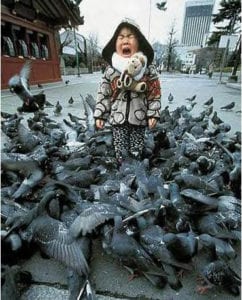
Pigeons terrifying child
FAMILY BEHAVIORS
Pigeons have been observed to be monogamous and exhibit a high degree of parental care:
- They usually lay only one or two eggs at a time, and they hatch after only 17 to 20 days.
- Young pigeons are fed “crop milk” from both male and female parents. This is a white substance secreted on a mature pigeon’s crop, which is basically an enlarged part of the esophagus.
Once these fledglings reach four to six weeks of age, they leave their parents’ nests for good. But before these youngsters have left the nest, more eggs are laid. This occurs during all four seasons, meaning that pigeon numbers increase drastically the longer they are left to their own devices.
Still, these young pigeons remain with the flock and continue to utilize lofts, attics and other concealed locations in and around structures as their roosting spots after they have fled the nest.
A PUBLIC HEALTH PEST
Because of their rapidly increasing numbers, pigeons rely heavily on humans for their food sources, as well as roosting and nesting sites. These birds only require 1 ounce of water per day, meaning just a small amount of stagnant water or snow is all they need. Pigeons in rural regions feed on seed and grain frequently, posing a major problem for farmers. In urban settings, they scavenge for whatever they can find — from littered food in streets and sidewalks to open dumpsters. The more improperly stored and disposed of food supply you provide, the more pigeons you will have.
While pigeons usually live up to 15 years in captivity, feral pigeons often only have a lifespan of 3 to 4 years. They often die of one of the various diseases they are known to carry, or else because of a predator.
Their nesting material, made up of twigs, leaves, and straw, is often reused for the whole year. It hardens after a few uses from their droppings, and is a serious health risk: Not only is the nest where their diseases can spread, it is also a perfect environment for bird mites. Left there long enough, the bird mites spread to whatever other suitable habitat they can find — and often, entire buildings.
Why do pigeons rely so much on humans to survive? There are two main reasons:
- The majority of the North American pigeon population originated from domesticated birds that had escaped. They became accustomed to relying on people for their food and water sources over time, and they stayed near us as a result.
- The various pigeon species have a common ancestor, whose original habitat was cliff sides and steep rock faces, resulting in the common name of “rock dove.” Cities with skyscrapers and tall buildings that provide ledges and overhangs for them to roost on are the closest thing they have to their native homes in many regions,. Thus, they stay there out of instinct.
Source
Pigeon Patrol Products & Services is the leading manufacturer and distributor or bird deterrent (control) products in Canada. Pigeon Patrol products have solved pest bird problems in industrial, commercial, and residential settings since 2000, by using safe and humane bird
deterrents with only bird and animal friendly solutions. At Pigeon Patrol, we manufacture and offer a variety of bird deterrents, ranging from Ultra-flex Bird Spikes with UV protection, Bird Netting, 4-S Bird Gel and the best Ultrasonic and audible sound devices on the market today.
Voted Best Canadian wholesaler for Bird Deterrent products ten years in a row.
Contact us at 1 877-4-NO-BIRD,(604) 585-9279 or visit our website at www.pigeonpatrol.ca
Pigeon/Pigeon Patrol / Pigeons Roosing / Vancouver Pigeon Control / Bird Spikes / Bird Control / Bird Deterrent / PIgeon Deterrent / Surrey Pigeon Control / Pest / Seagull deterrent / Vancouver Pigeon Blog / Birds Inside Home / Pigeons in the cities / Ice Pigeons / What to do about pigeons / sparrows, Damage by Sparrows, How to Keep Raccoons Away, Why Are Raccoons Considered Pests / De-fence / Pigeon Nesting / Bird Droppings / Pigeon Dropping / woodpecker control / Professional Bird Control Company / Keep The Birds Away / Birds/rats/seagull/pigeon/woodpecker/dove/sparrow/pidgeon control/pidgeon problem/pidgeon control/flying rats/pigeon problems/ bird netting/bird gel/bird spray/bird nails/bird guard

by Pigeon Patrol | May 18, 2023 | Bird Spike, Pigeon Droppings, Pigeon Patrol's Services, Pigeon Predators, Pigeon Spikes, Pigeons, Pigeons in the News
In Pittsburgh, Memphis and Los Angeles, massive billboards recently popped up declaring, “Birds Aren’t Real.”
On Instagram and TikTok, Birds Aren’t Real accounts have racked up hundreds of thousands of followers, and YouTube videos about it have gone viral.
Last month, Birds Aren’t Real adherents even protested outside Twitter’s headquarters in San Francisco to demand that the company change its bird logo.
The events were all connected by a Gen Z-fueled conspiracy theory, which posits that birds don’t exist and are really drone replicas installed by the U.S. government to spy on Americans. Hundreds of thousands of young people have joined the movement, wearing Birds Aren’t Real T-shirts, swarming rallies and spreading the slogan.
It might smack of QAnon, the conspiracy theory that the world is controlled by an elite cabal of child-trafficking Democrats. Except that the creator of Birds Aren’t Real and the movement’s followers are in on a joke: They know that birds are, in fact, real and that their theory is made up.
What Birds Aren’t Real truly is, they say, is a parody social movement with a purpose. In a post-truth world dominated by online conspiracy theories, young people have coalesced around the effort to thumb their nose at, fight and poke fun at misinformation. It’s Gen Z’s attempt to upend the rabbit hole with absurdism.
“It’s a way to combat troubles in the world that you don’t really have other ways of combating,” said Claire Chronis, 22, a Birds Aren’t Real organizer in Pittsburgh. “My favorite way to describe the organization is fighting lunacy with lunacy.”
At the center of the movement is Peter McIndoe, 23, a floppy-haired college dropout in Memphis who created Birds Aren’t Real on a whim in 2017. For years, he stayed in character as the conspiracy theory’s chief believer, commanding acolytes to rage against those who challenged his dogma. But now, Mr. McIndoe said in an interview, he is ready to reveal the parody lest people think birds really are drones.
“Dealing in the world of misinformation for the past few years, we’ve been really conscious of the line we walk,” he said. “The idea is meant to be so preposterous, but we make sure nothing we’re saying is too realistic. That’s a consideration with coming out of character.”
Most Birds Aren’t Real members, many of whom are part of an on-the-ground activism network called the Bird Brigade, grew up in a world overrun with misinformation. Some have relatives who have fallen victim to conspiracy theories. So for members of Gen Z, the movement has become a way to collectively grapple with those experiences. By cosplaying conspiracy theorists, they have found community and kinship, Mr. McIndoe said.
“Birds Aren’t Real is not a shallow satire of conspiracies from the outside. It is from the deep inside,” he said. “A lot of people in our generation feel the lunacy in all this, and Birds Aren’t Real has been a way for people to process that.”
Cameron Kasky, 21, an activist from Parkland, Fla., who helped organize the March for Our Lives student protest against gun violence in 2018 and is involved in Birds Aren’t Real, said the parody “makes you stop for a second and laugh. In a uniquely bleak time to come of age, it doesn’t hurt to have something to laugh about together.”
Mr. McIndoe, too, marinated in conspiracies. For his first 18 years, he grew up in a deeply conservative and religious community with seven siblings outside Cincinnati, then in rural Arkansas. He was home-schooled, taught that “evolution was a massive brainwashing plan by the Democrats and Obama was the Antichrist,” he said.
He read books like “Remote Control,” about what it said were hidden anti-Christianity messages from Hollywood. In high school, social media offered a gateway to mainstream culture. Mr. McIndoe began watching Philip DeFranco and other popular YouTubers who talked about current events and pop culture, and went on Reddit to find new viewpoints.
“I was raised by the internet, because that’s where I ended up finding a lot of my actual real-world education, through documentaries and YouTube,” Mr. McIndoe said. “My whole understanding of the world was formed by the internet.”
By the time Mr. McIndoe left home for the University of Arkansas in 2016, he said, he realized he wasn’t the only young person forced to straddle multiple realities.
Then in January 2017, Mr. McIndoe traveled to Memphis to visit friends. Donald J. Trump had just been sworn in as president, and there was a women’s march downtown. Pro-Trump counterprotesters were also there. When Mr. McIndoe saw them, he said, he ripped a poster off a wall, flipped it over and wrote three random words: “Birds Aren’t Real.”
“It was a spontaneous joke, but it was a reflection of the absurdity everyone was feeling,” he said.
Mr. McIndoe then walked around and improvised the Birds Aren’t Real conspiracy lore. He said he was part of a greater movement that believed that birds had been replaced with surveillance drones and that the cover up began in the 1970s. Unbeknown to him, he was filmed and the video posted on Facebook. It went viral, especially among teenagers in the South.
In Memphis, “Birds Aren’t Real” graffiti soon showed up. Photos of the phrase’s being scrawled on chalkboards and the walls of local high schools surfaced. People made “Birds Aren’t Real” stickers.
Mr. McIndoe decided to lean into Birds Aren’t Real. “I started embodying the character and building out the world this character belonged to,” he said. He and Connor Gaydos, a friend, wrote a false history of the movement, concocted elaborate theories and produced fake documents and evidence to support his wild claims.
“It basically became an experiment in misinformation,” Mr. McIndoe said. “We were able to construct an entirely fictional world that was reported on as fact by local media and questioned by members of the public.”
Mr. Gaydos added, “If anyone believes birds aren’t real, we’re the last of their concerns, because then there’s probably no conspiracy they don’t believe.”
In 2018, Mr. McIndoe dropped out of college and moved to Memphis. To build Birds Aren’t Real further, he created a flyer that shot to the top of Reddit. He hired an actor to portray a former C.I.A. agent who confessed to working on bird drone surveillance; the video has more than 20 million views on TikTok. He also hired actors to represent adult bird truthers in videos that spread all over Instagram.
That same year, Mr. McIndoe began selling Birds Aren’t Real merchandise. The money, totaling several thousand dollars a month, helps Mr. McIndoe and Mr. Gaydos cover their living expenses.
“All the money from our merch lineup goes into making sure me and Connor can do this full time,” Mr. McIndoe said. “We also put the money into the billboards, flying out members of the Bird Brigade to rallies. None of the proceeds go to anything harmful.”
To adults with concerns about Mr. McIndoe’s tactics, researchers said any harms were most likely minimal.
“You have to weigh the potential negative effects with any of this stuff, but in this case it is so extremely small,” said Joshua Citarella, an independent researcher who studies internet culture and online radicalization in youth. “Allowing people to engage in collaborative world building is therapeutic because it lets them disarm conspiracism and engage in a safe way.”
Mr. McIndoe said he kept the concerns top of mind. “Everything we’ve done with Birds Aren’t Real is made to make sure it doesn’t tip into where it could have a negative end result on the world,” he said. “It’s a safe space for people to come together and process the conspiracy takeover of America. It’s a way to laugh at the madness rather than be overcome by it.”
The effort has been cathartic for young people including Heitho Shipp, 22, a Pittsburgh resident.
“Most conspiracy theories are fueled by hate or distrust or one powerful leader, but this is about finding an outlet for our pain,” she said. She added that the movement was “more about media literacy.”
Birds Aren’t Real members have also become a political force. Many often join up with counterprotesters and actual conspiracy theorists to de-escalate tensions and delegitimize the people they are marching alongside with irreverent chants.
In September, shortly after a restrictive new abortion law went into effect in Texas, Birds Aren’t Real members showed up at a protest held by anti-abortion activists at the University of Cincinnati. Supporters of the new law “had signs with very graphic imagery and were very aggressive in condemning people,” Mr. McIndoe said. “It led to arguments.”
But the Bird Brigade began chanting, “Birds aren’t real.” Their shouts soon overpowered the anti-abortion activists, who left.
Mr. McIndoe now has big plans for 2022. Breaking character is necessary to help Birds Aren’t Real leap to the next level and forswear actual conspiracy theorists, he said. He added that he hoped to collaborate with major content creators and independent media like Channel 5 News, which is aimed at helping people make sense of America’s current state and the internet.
“I have a lot of excitement for what the future of this could be as an actual force for good,” he said. “Yes, we have been intentionally spreading misinformation for the past four years, but it’s with a purpose. It’s about holding up a mirror to America in the internet age.”
Source
Pigeon Patrol Products & Services is the leading manufacturer and distributor or bird deterrent (control) products in Canada. Pigeon Patrol products have solved pest bird problems in industrial, commercial, and residential settings since 2000, by using safe and humane bird
deterrents with only bird and animal friendly solutions. At Pigeon Patrol, we manufacture and offer a variety of bird deterrents, ranging from Ultra-flex Bird Spikes with UV protection, Bird Netting, 4-S Bird Gel and the best Ultrasonic and audible sound devices on the market today.
Voted Best Canadian wholesaler for Bird Deterrent products ten years in a row.
Contact us at 1 877-4-NO-BIRD,(604) 585-9279 or visit our website at www.pigeonpatrol.ca
Pigeon/Pigeon Patrol / Pigeons Roosing / Vancouver Pigeon Control / Bird Spikes / Bird Control / Bird Deterrent / PIgeon Deterrent / Surrey Pigeon Control / Pest / Seagull deterrent / Vancouver Pigeon Blog / Birds Inside Home / Pigeons in the cities / Ice Pigeons / What to do about pigeons / sparrows, Damage by Sparrows, How to Keep Raccoons Away, Why Are Raccoons Considered Pests / De-fence / Pigeon Nesting / Bird Droppings / Pigeon Dropping / woodpecker control / Professional Bird Control Company / Keep The Birds Away / Birds/rats/seagull/pigeon/woodpecker/dove/sparrow/pidgeon control/pidgeon problem/pidgeon control/flying rats/pigeon problems/ bird netting/bird gel/bird spray/bird nails/bird guard
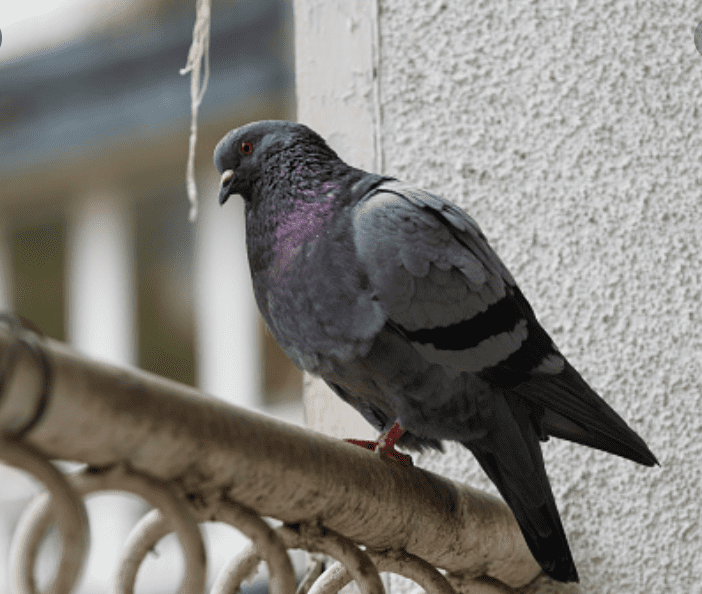
by Pigeon Patrol | May 9, 2023 | history of pigeons, MBCA, pet bird, Pigeon Control, Pigeon Droppings, Pigeon Patrol's Services, Pigeon Predators, Pigeon Spikes
For a month the researchers had traversed slender mountain ridges, crossed and re-crossed rivers that roared through canyons cloaked in tropical forest, and endured bloodthirsty mosquitoes and leeches, all in search of something that probably didn’t exist. They had just hours left for searching before they had to leave Fergusson Island, off the east coast of Papua New Guinea. Expedition co-leader Jordan Boersma reckoned their chance of success was less than 1 percent.
Winded from a climb, he plopped down on a lush hillside to catch his breath and began looking through images on the camera traps he’d just collected, not expecting to find anything. “Suddenly I was confronted with this image of what at that time felt like a mythical creature,” says Boersma, a postdoctoral researcher at the Cornell Lab of Ornithology. “It was, without exaggeration, the most surreal moment of my life.”
The camera’s display was tiny, but there was no mistaking the creature it showed: the Black-naped Pheasant-Pigeon, a species that hasn’t been documented by scientists since it was first described in 1882.
“To find something that’s been gone for that long, that you’re thinking is almost extinct, and then to figure out that it’s not extinct, it feels like finding a unicorn or a Bigfoot,” says John C. Mittermeier, director of the lost birds program at American Bird Conservancy and a co-leader of the eight-member expedition. “It’s extraordinarily unusual.”
The stunning late-September rediscovery could not have happened without guidance from local hunters with intimate knowledge of the island’s forests, the researchers say, demonstrating the invaluable role of Indigenous communities in ongoing efforts to relocate species lost to Western science. With its existence confirmed, the Black-naped Pheasant-Pigeon is almost certainly the most endangered bird in New Guinea, which underscores the urgent need to protect its habitat on Fergusson, a rugged, 555-square-mile island that, while largely undeveloped, faces pressure from logging companies.
“This is a huge discovery,” says Bulisa Iova, an expedition member and acting chief curator of the National Museum and Art Gallery in Papua New Guinea. “I have studied birds for many years, and to be part of this team to discover this lost species is a highlight for me.”
The expedition was part of The Search for Lost Birds, a collaboration between BirdLife International, Re:wild, and American Bird Conservancy, which funded the trip. The initiative aims to rediscover more than 150 avian species that haven’t been declared extinct but also have not been seen for at least a decade.
A chicken-size, ground-dwelling pigeon, the Black-naped Pheasant-Pigeon was among around 20 “lost” birds that have not been documented for more than a century. It’s one of four pheasant-pigeon species found around New Guinea, and lives only on Fergusson Island. (Some authorities consider the four varieties to be subspecies.)
Boersma previously searched for the Black-naped Pheasant-Pigeon in 2019 with Jason Gregg, a conservation biologist and Audubon magazine contributor, and local biologist Doka Nason. While the trio did not find the bird on that trip, they did turn up five bird species not previously known to live on Fergusson, which suggested there were significant gaps in what ornithologists knew about the island’s birdlife. And when they spoke with hunters, they heard reports of a bird whose description could only belong to the pheasant-pigeon.
The researchers returned to Fergusson with a larger team in early September, determined to establish trust and work closely with the island’s Indigenous inhabitants to find the species. Day after day they hiked the steep terrain, stopping to interview locals and sleeping in villages or camping in the forest. Hunters in the first few communities were unfamiliar with the large bird the researchers described. But when the team reached the remote western slope of Mt. Kilkerran, they began to meet villagers who recognized the species and referred to it by the name Auwo.
Finally, in the village of Duda Ununa, a hunter named Augustin Gregory told the researchers where he had seen the bird. He described a call that matched those of New Guinea’s other pheasant-pigeon species, which don’t live on Fergusson. And he showed the team an area, on a ridge 3,200 feet above sea level and covered in thick vegetation, where their motion-triggered camera traps were likely to snap the elusive bird. Nason, who grew up in Papua New Guinea near Fergusson, and who Boersma describes as “the most impressive field biologist I’ve worked with anywhere,” selected a spot and set up the camera.
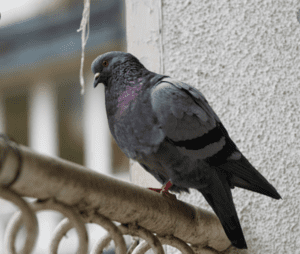
With its vantage limited by dense understory, the site wasn’t a typical one for a camera trap, the scientists say, but the images proved it was the right one. “Unmistakable,” Gregg, an expedition co-leader, says of first seeing the photos. “Tons of mixed emotions. Everything from solemn relief of burden to fist-pumping and screaming.”
Only days later, with time to scroll through everything the traps had captured, did the team realize that another camera had recorded video of a pheasant-pigeon. Given that the images were taken several kilometers apart, they almost certainly show two individuals.
Now that scientists know the Black-naped Pheasant-Pigeon still exists, the focus becomes keeping the critically endangered species from going extinct. As with other once-lost birds, its population is likely very small and seriously imperiled. Logging by international corporations appears to be a growing threat, and introduced predators such as feral cats could take a toll on the pheasant-pigeon as they have on other endemic island birds, according to Gregg. Sustaining the long-lost species will require learning more about its behavior and population status and launching conservation projects to protect its habitat, all with Fergusson Island residents in a leading role.
“Knowing what we know about bird extinction and conservation on islands around the world, we can expect that the combination of logging and introduced species, especially introduced mammals, is going to have an impact,” Gregg says. “This land and the fate of any conservation work that happens on this land is completely up to the communities that live there and own the land.”
Beyond Fergusson Island’s luxuriant forests, the rediscovery of the Black-naped Pheasant-Pigeon raises hopes that future expeditions will turn up other species lost to science but known all along to local experts. “The way this was always going to work is that we just really lean into local knowledge and put our faith in our local partners,” Boersma says. “That’s what delivered this incredible moment for us.”
Source
Pigeon Patrol Products & Services is the leading manufacturer and distributor or bird deterrent (control) products in Canada. Pigeon Patrol products have solved pest bird problems in industrial, commercial, and residential settings since 2000, by using safe and humane bird
deterrents with only bird and animal friendly solutions. At Pigeon Patrol, we manufacture and offer a variety of bird deterrents, ranging from Ultra-flex Bird Spikes with UV protection, Bird Netting, 4-S Bird Gel and the best Ultrasonic and audible sound devices on the market today.
Voted Best Canadian wholesaler for Bird Deterrent products ten years in a row.
Contact us at 1 877-4-NO-BIRD,(604) 585-9279 or visit our website at www.pigeonpatrol.ca
Pigeon/Pigeon Patrol / Pigeons Roosing / Vancouver Pigeon Control / Bird Spikes / Bird Control / Bird Deterrent / PIgeon Deterrent / Surrey Pigeon Control / Pest / Seagull deterrent / Vancouver Pigeon Blog / Birds Inside Home / Pigeons in the cities / Ice Pigeons / What to do about pigeons / sparrows, Damage by Sparrows, How to Keep Raccoons Away, Why Are Raccoons Considered Pests / De-fence / Pigeon Nesting / Bird Droppings / Pigeon Dropping / woodpecker control / Professional Bird Control Company / Keep The Birds Away / Birds/rats/seagull/pigeon/woodpecker/dove/sparrow/pidgeon control/pidgeon problem/pidgeon control/flying rats/pigeon problems/ bird netting/bird gel/bird spray/bird nails/bird guard
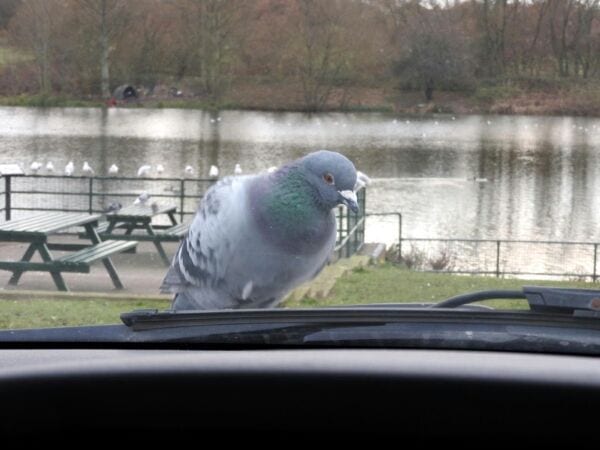
by Pigeon Patrol | May 9, 2023 | Bird Spike, Pigeon Predators, Pigeon Spikes, Pigeons, Pigeons in the News, Raccoons, Sparrows, UltraSonic Bird Control
Two patients have died at a hospital after contracting a fungal infection linked to pigeon droppings.
The individuals are thought have caught the airborne disease at the Queen Elizabeth University hospital in Glasgow after inhaling the fungus cryptococcus, typically found in soil and pigeon droppings.
NHS Greater Glasgow and Clyde (NHSGGC), which runs the hospital, has launched an investigation into the outbreak. It said the likely source of the pigeon droppings was a non-public room, thought to contain machinery, which has now been cleaned.
NHSGGC said “control measures” had been introduced, which is understood to mean equipment to filter the air in some parts of the hospital, and that some patients, including children, who may be vulnerable to the disease have received medication, which was proving effective.
The health board said that the second patient who died was elderly and the death was due to an unrelated matter. It said it could not share further details of the case because of patient confidentiality.
Teresa Inkster, NHSGGC lead consultant for infection control, said: “Cryptococcus lives in the environment throughout the world. It rarely causes infection in humans. People can become infected with it after breathing in the microscopic fungi, although most people who are exposed to it never get sick from it.”
She said there had been no further cases since control measures were put in place. “We are continuing to monitor the air quality and these results are being analysed. It remains our priority to ensure a safe environment for patients and staff,” she added.
Portable air filters have been installed to help reassure “vulnerable patients”, NHSGGC said, adding that the organism is “harmless to the vast majority of people and rarely causes disease in humans”. A group of hospital patients are being moved within the hospital “due to their clinical diagnosis and ongoing treatment”.
Source
Pigeon Patrol Products & Services is the leading manufacturer and distributor or bird deterrent (control) products in Canada. Pigeon Patrol products have solved pest bird problems in industrial, commercial, and residential settings since 2000, by using safe and humane bird
deterrents with only bird and animal friendly solutions. At Pigeon Patrol, we manufacture and offer a variety of bird deterrents, ranging from Ultra-flex Bird Spikes with UV protection, Bird Netting, 4-S Bird Gel and the best Ultrasonic and audible sound devices on the market today.
Voted Best Canadian wholesaler for Bird Deterrent products ten years in a row.
Contact us at 1 877-4-NO-BIRD,(604) 585-9279 or visit our website at www.pigeonpatrol.ca
Pigeon/Pigeon Patrol / Pigeons Roosing / Vancouver Pigeon Control / Bird Spikes / Bird Control / Bird Deterrent / PIgeon Deterrent / Surrey Pigeon Control / Pest / Seagull deterrent / Vancouver Pigeon Blog / Birds Inside Home / Pigeons in the cities / Ice Pigeons / What to do about pigeons / sparrows, Damage by Sparrows, How to Keep Raccoons Away, Why Are Raccoons Considered Pests / De-fence / Pigeon Nesting / Bird Droppings / Pigeon Dropping / woodpecker control / Professional Bird Control Company / Keep The Birds Away / Birds/rats/seagull/pigeon/woodpecker/dove/sparrow/pidgeon control/pidgeon problem/pidgeon control/flying rats/pigeon problems/ bird netting/bird gel/bird spray/bird nails/bird guard







